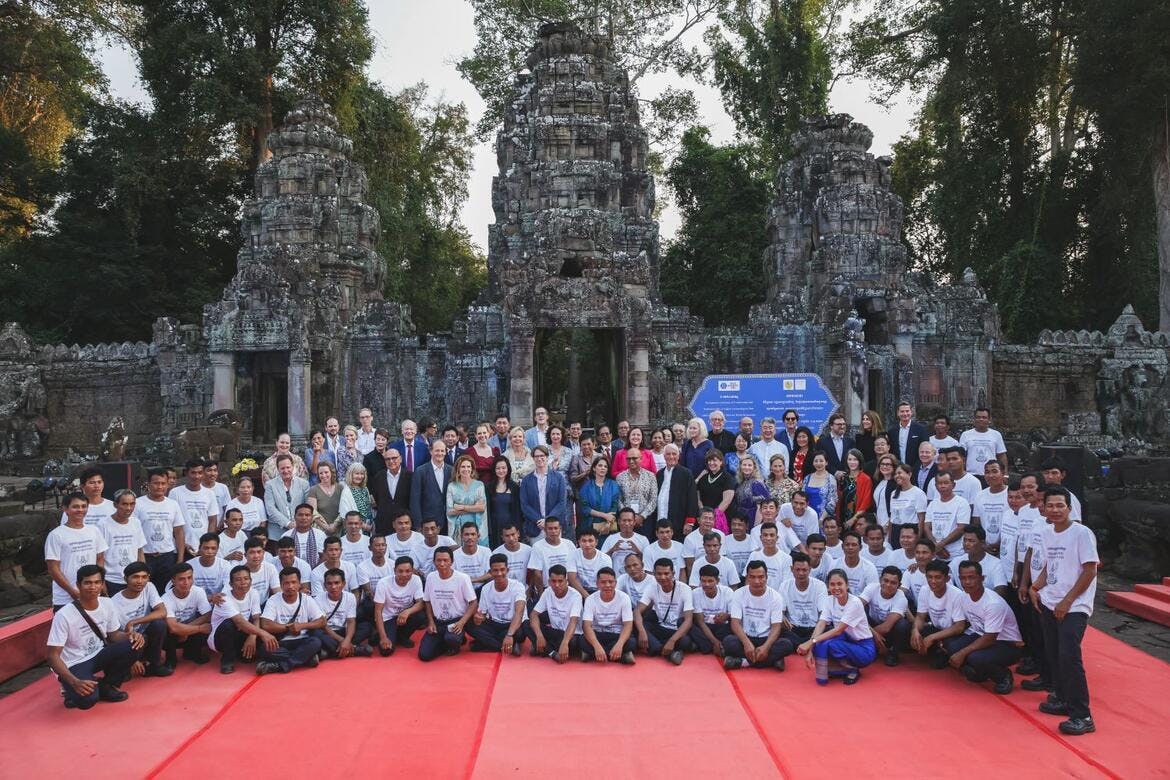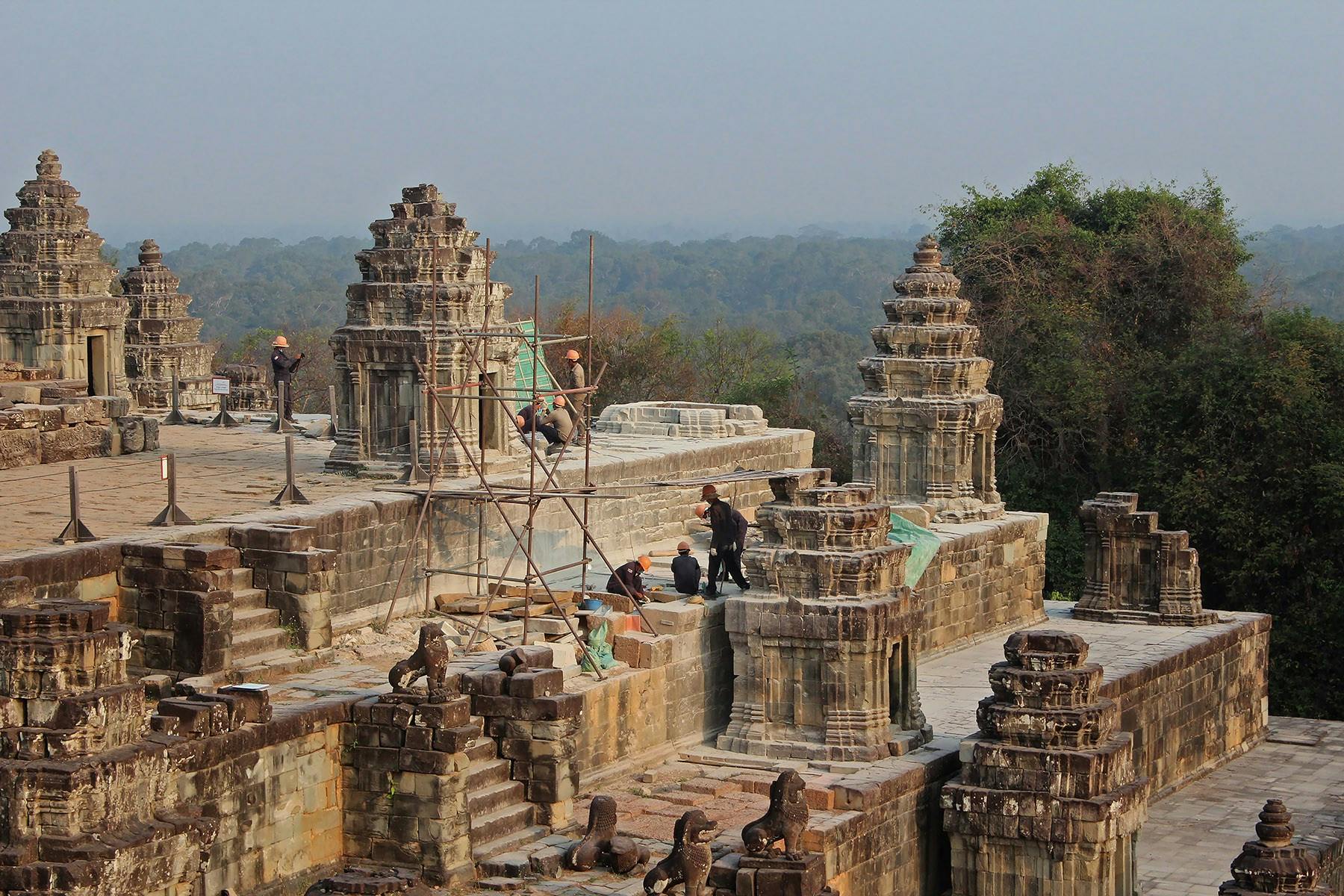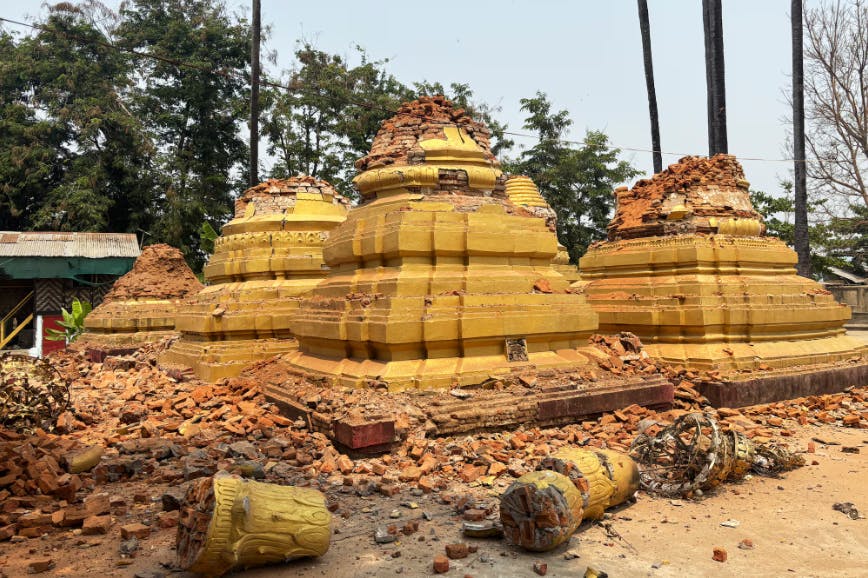Sunrise to Sunset in Angkor: A Cambodia Travelogue by Bénédicte de Montlaur
- Bénédicte de Montlaur
When World Monuments Fund (WMF) was first invited to survey the temples of Angkor Archaeological Park, Cambodia was emerging from decades of civil strife that had taken an enormous toll on the country and its heritage. Thirty-five years later, I found myself walking down the same paths that the initial team must have taken all those decades ago, only the contrast between what we saw couldn’t have been greater. After over three decades of hard work across four sites—in partnership with the Authority for the Protection of the Site and Management of the Region of Angkor (APSARA)—buildings that had once been at risk of collapse have been stabilized, entryways once blocked by debris have been cleared, and a city once choked and shrouded in shadow from jungle overgrowth has been brought to the light once more.
I had the opportunity to travel to Cambodia in January as part of our most recent Monumental Journeys trip, which was organized to coincide with 35th anniversary celebrations. At Angkor, we were also honoring the fact that APSARA was officially taking over future conservation management at three of the four sites where we had previously worked (Preah Khan, Ta Som, and Angkor Wat’s Churning of the Ocean of Milk Gallery); at the fourth, Phnom Bakheng, we will be starting a new phase of work with support from the U.S Department of State, the U.S. Ambassadors Fund for Cultural Preservation (AFCP), and the U.S. Embassy in Phnom Penh. Our group was privileged to have Ginevra Boatto, Regional Representative for Southeast Asia, as our expert guide on the history of the Khmer Empire. We were lucky to be privy to experiences few travelers to Cambodia are afforded. Our group got a private tour of Angkor Conservation, a center usually closed to the public that houses over 5,000 sculptures and carved stone stelae from throughout Angkor Archaeological Park. We were also treated to traditional Khmer cuisine, performances by the Sacred Dancers of Angkor, and a shadow puppet show in the grandiose setting of Prasat Kravan Temple. Among the most spectacular moments on the trip was crossing West Baray, the world’s largest artificial reservoir, in a chartered boat, an experience that truly drove home the genius of Angkor’s engineers.
Outside of the Archaeological Park, our group had the opportunity to stroll through Kok Tnout, one of the most beautiful and unspoiled rice-growing villages in the region. We also explored the step pyramids of Koh Ker, the former Khmer capital and a recently inscribed UNESCO World Heritage site. After being heavily looted, many Khmer sculptures from Koh Ker and other sites are finally finding their way back to Cambodia. Our group was given context on this complex and sensitive issue at other times on the trip by the Cambodian Minister of Culture and Bradley Gordon, founder of Edenbridge Asia, who has worked to spearhead the return of Cambodian artworks. Artist Lim Muy Theam graciously invited our group into his home for an evening devoted to learning about the vibrant contemporary Cambodian art scene.
But of course, no visit to Cambodia would be complete without a pilgrimage to Angkor, and it was there that we spent the lion’s share of our time, from taking in the sunrise over the towers of Angkor Wat to a lavish Khmer dinner at Prasat Kravanh Temple. It was there that we gathered to celebrate 35 years of extraordinary hard work on the part of our staff and partners.
With years of painstaking labor—often disassembling and reassembling parts of the temples block by block—the team here has helped safeguard icons of world heritage that were once in grave danger. Yet our celebration at Angkor was also a demonstration of the fact that the impact of heritage and its preservation goes far beyond the physical fabric of the structures themselves. The conservation of Angkor has created numerous jobs for local people, and WMF is proud to be part of this effort. Our commitment to Angkor and Cambodia remains intact as we carry on the next phase of our work at the magnificent Phnom Bakheng Temple while elaborating plans with the Cambodian authorities for improved training and education programs both at a local and national level.
Heritage strengthens communities and fosters bonds across time and space—and the decades-long collaboration to preserve Angkor is one of the most eloquent testimonies to that fact that I know.
Bénédicte de Montlaur
President and CEO
Bénédicte de Montlaur is President and Chief Executive Officer of World Monuments Fund (WMF), the world’s foremost private organization dedicated to saving extraordinary places while empowering the communities around them. She is responsible for defining WMF’s strategic vision, currently implementing that vision in more than 30 countries around the world and leading a team that spans the globe.
Her background mixes culture and the arts, politics, international diplomacy and human rights. Prior to joining WMF, Montlaur spent two decades working across three continents as a senior diplomat at the French Ministry of Foreign Affairs.
Most recently, she served as Cultural Counselor of the French Embassy in the United States, leading France’s largest international cultural advocacy network and its two partner foundations—Albertine and FACE—and directing a team of 90 people in ten US offices. In this role, Montlaur created and expanded numerous programs, including the French-American Dual Language Fund, the annual Festival Albertine featuring curators including Ta-Nehisi Coates and Gloria Steinem, and the podcast The Thing About France, which presented conversations with prominent Americans about their country’s relationship with France. Previously, she served as Deputy Assistant Secretary in charge of North Africa, United Nations Security Council Negotiator on Africa and the Middle East and French Embassy First Secretary in Damascus, Syria.
Montlaur studied sociology and Arabic at the Ecole Normale Supérieure (Ulm) and public affairs at Sciences Po, Paris. She was a Marshall Memorial Fellow at the German Marshall Fund. She has served on the Boards of several cultural and educational institutions, and is currently a Trustee of the Menil Collection in Houston, Texas. Montlaur is a member of The New York Times literary critic Liesl Schillinger’s book club and created an original exhibition of photos entitled “Islam and the City.” Beyond her professional accomplishments, Montlaur is a polyglot—speaking French, English, Arabic and Spanish—and completed the New York City Marathon in 2011.









